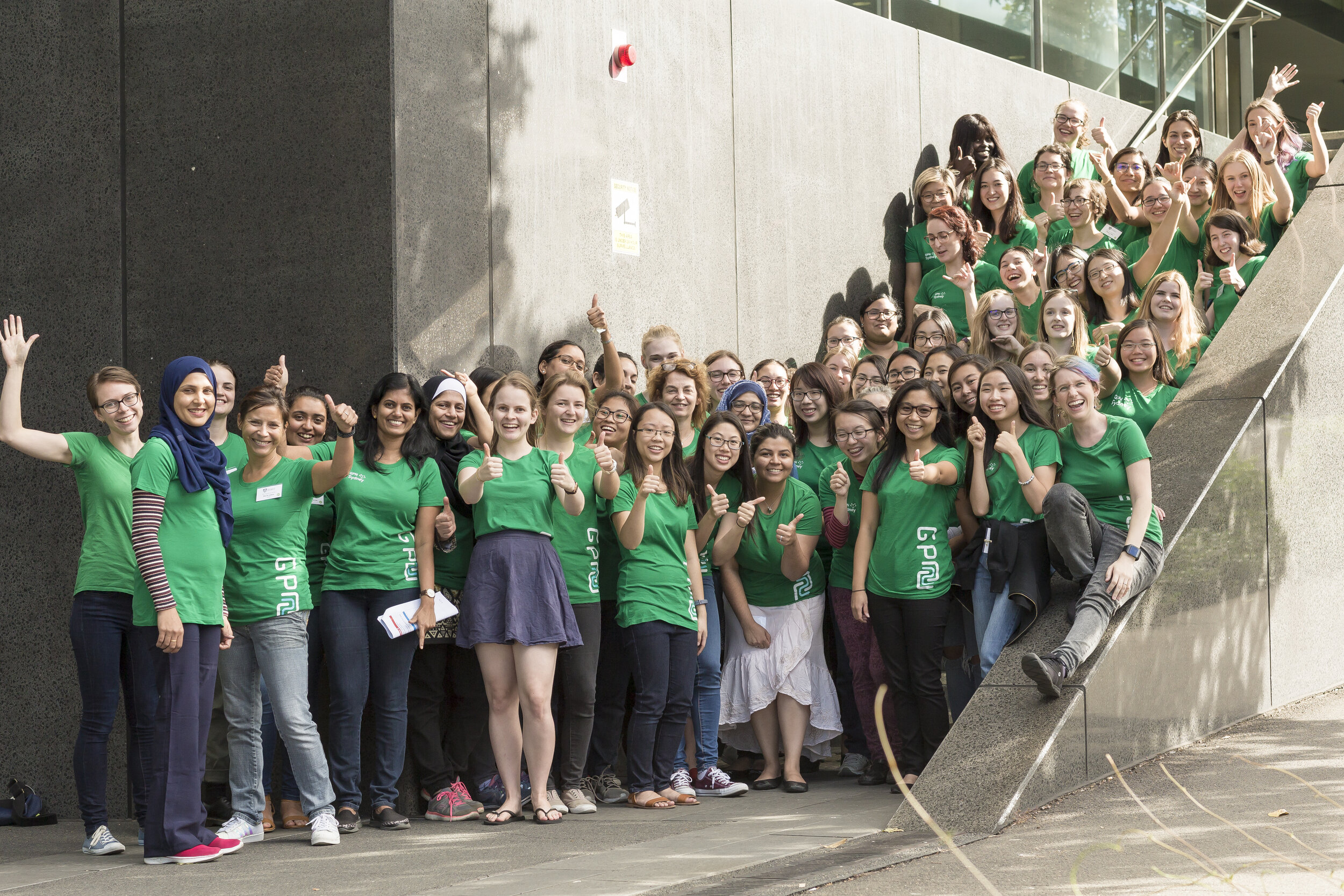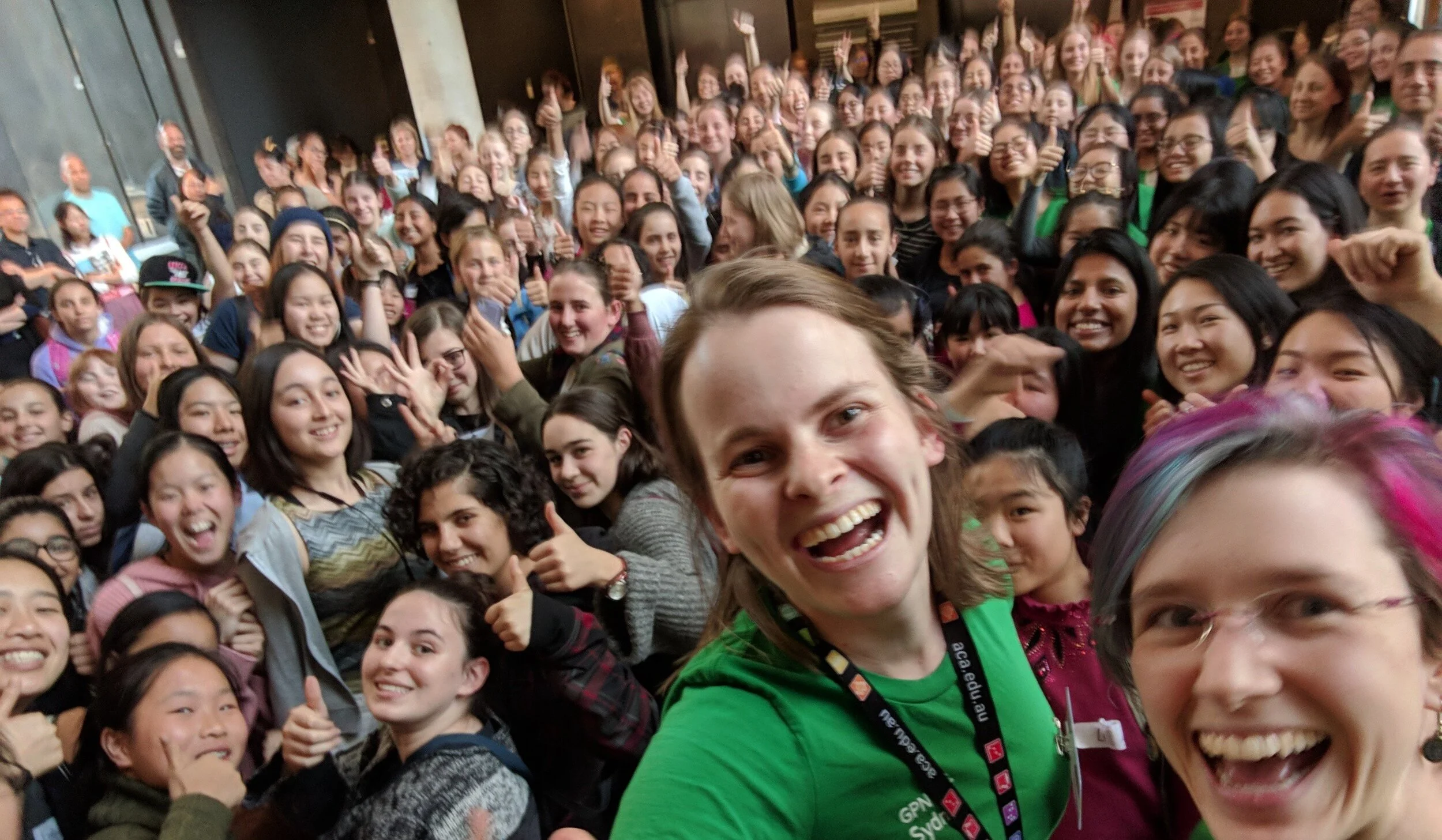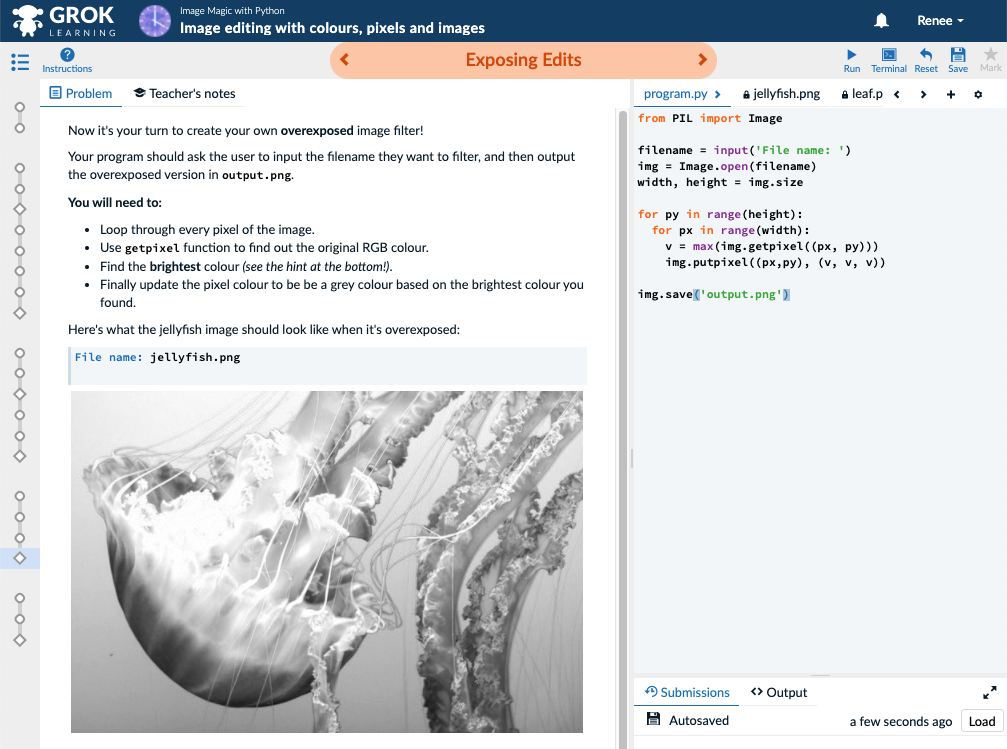Educational Content Portfolio
Sample materials
Down the page are samples examples of my work in content creation used through at the Girls’ Programming Network, Grok Learning, and ConnectEd Code. These include:
ConnectEd Code
Introduction to Kookaberry project to create a whistling countdown timer. A Python/KookaIDE project for high school students with experience in Python to become familiar with Kookaberry.
Music/tech cross-curricular mini projects for creating musical instruments with Kookaberry and Kookablockly.
ConnectEd Code’s Python cheat sheet
Girls’ Programming Network:
A selection of the different GPN courses I architected, wrote and/or mentored volunteers through contributing to. These demonstrate my methodology behind differentiated programming projects.
Videos of my conference talks explaining my methodology behind creating GPN resources, and my quantitative method for evaluating material difficulty for different student levels.
One of the many unplugged activities I have created.
Grok Learning
Some samples of a course I put together for Grok Learning, featuring student and teacher resources.
Blogs detailing my approach to content creation.
Description of other Grok work. (Most Grok content sits behind a pay wall and can’t be shared.)
Experience
While I always loved the act of teaching, it is the last 8 years that have lead me to become heavily involved in the development of educational content for STEM education.
Over this time I have progressed from my early roles such as tutor at the University of Sydney and summer camp tutor, to nationalising the Girls’ Programming Network outreach program and working as a software and Content Developer at Grok Learning. Most recently I started my own business, ConnectEd Code, providing tech-education resources, experiences, and consultation, and began working as a teacher at PLC Sydney for their Cambridge Computer Science course. Through this work I have amassed a broad range of experience in designing content for students, ranging for years 3 to 12 in a variety of contexts.
School Based Curriculum Aligned Context Material
In the three years I spent working at Grok Learning I was involved in the development and architecture of numerous courses and competition materials. In this period Grok focussed on aligning its materials to the Australian Curriculum, affording me copious experience in designing and mapping concepts and content to the Digital Technologies Curriculum for years 5 - 10.
Most recently, my business ConnectEd Code has begun a number of projects with the AustSTEM Foundation, preparing project mappings for a variety of materials and in-person experiences. In addition to that, my work at PLC Sydney has brought a new experience with curriculum mapping to my repertoire, in working with the Cambridge IGCSE and O Level Curriculum.
In-Person Event Material
Through the Girls’ Programming Network, NCSS Summer School, and various other outreach engagements through ConnectEd Code and Grok Learning, I have spent extensive time developing materials for in-person workshops and PD events. These event materials have been targeted at people with all levels of experience, from students in years 3-12, to university students, to teachers and pre-service teachers.

ConnectEd Code
Whistling Timer - Kookaberry
This project was designed to give students who are familiar with Python a basic understanding of the Kookaberry and it’s peripherals. In this project students build a count down timer that with a decreasing pitch whistle that plays as time runs out. In doing this they gain an understanding of embedded systems programming, encountering concepts as:
The need for a main loop to continuously run in order to be able to poll for user inputs.
The use of various aspects of timing from sleeping the code (blocking the program), to more sophisticated methods utilising the internal real time clock to increase accuracy.
Using the Kookaberry ports to add a speaker, and writing code featuring pulse width modulation to operate it.
To view a the Whistling Countdown Timer project click here.
Pre-service music teachers try their hand at playing the playdough xylophone.
Music Makers - Kookaberry
This series of mini-projects was designed for a guest session at the University of Sydney Conservatorium of Music, for an hour long guest lecture for their pre-service music teacher students. In this class I took them through how they could combine the Digital Technologies curriculum with the Music curriculum to create interesting new musical instruments.
The pre-service teachers, with no previous coding experience, were guided through a demonstration activity of how to code and use the Kookaberries to play and modulate musical pitch. Then they were given a collection of different musical apps to code and wire up to try for themselves and to adapt. By the end of the session the soon to be teachers had constructed moisture and playdough based xylophones, and even a gravity based musical instrument.
To view the collection of mini-projects click here, and see their creations in action below.
Python Cheat Sheet
A cheat sheet covering the Python concepts needed to cover the year 7-10 Australian Digital Technologies curriculum
To view a full sized PDF version of the cheat sheet click here.

Girls’ Programming Network
A GPN student’s creative circuitry extends their micro:bit Bop It game.
Bop It - BBC micro:bit
This project is our own take on the game/toy Bop It. Implemented using the BBC micro:bit, students have the chance to combine code with creative circuitry to design their own games.
The beauty in this project is its extendability, allowing new programmers to feel accomplished in coding the core game and building a basic circuit, while experienced programmers can extend their coding abilities by adding new scoring features, advanced circuitry, and even radio communications for multiplayer options.
To check out the Bop It activity book and it’s many extensions suitable for all levels click here.
Concept to Classroom: Creating Fun Differentiated Programming Projects
Renee Noble - Hopper Down Under Conference 2019
Tic Tac Toe - Python
This text-based Python implementation of Tic Tac Toe is a great example of my methodologies ability to differentiate a common idea into many difficulty levels. Ultimately students all make a 2-player Tic Tac Toe game, but do so using different programming concepts, depending on level, such that it is achievable but challenging for every student, with plenty of content to occupy speedy students too.
In this project new programmers solidify the concepts of variables, if statements and looping. Meanwhile intermediate level programmers extend themselves with lists and functions. The most advance programers have the opportunity to build an AI player onto their 2-player game, and learn about recursion and game trees.
Resources:
Scissors Paper Rock Your Classroom With Differentiated Learning
Renee Noble - PyCon Au 2019
Scissors Paper Rock - Python
The GPN Scissors Paper Rock project sparked the ideas behind my methodology for creating differentiated content that was easy to learn from and easy to teach. Years on this project has become our flagship project which all new GPN nodes use to get off the ground.
This project is conceptually relatable for students and teachers, yet has scope to be implemented and extended in a variety of ways, ensuring an accessible challenge for every child. Fine tuning over the years and addition of tutors solutions and tips to help our volunteers assist the girls in bringing their projects together has helped our new nodes learn how to deliver GPN project material. In particular, our regional nodes , which typically run by passionate school teachers with limited technical experience, have benefitted from our tutor resources and enabled them to deliver the GPN program in areas where tech-trained industry professionals and university students are scarce.
Resources:
GPN students and their squishy circuit solution.
Squishy Circuits - Unplugged
The Squishy Circuits activity uses hands on activities to give students an understanding of electronics and circuits as well as the logic gates that make up computer systems. Using the conductive properties of playdough, along side a battery and LED light, students construct logic gates that can provide the answer to questions given yes or no answers input into the circuits via “switches” made of aluminium foil.
To see the student activity book for the squishy circuit activity click here.
Educational Success Through Girls’ Programming Network
Leader of the Year
ICT Educators NSW
In 2017 Girls’ Programming Network founder Nicky Ringland and I were fortunate to receive the ICT Educators NSW Leader of the Year award for the impact of the program on engaging girls in tech, and broad application of the materials emanating from the program.
100 Women of Influence
Australian Financial Review
In 2019 I found myself list on the AFR’s 100 Women of Influence list for my work in engaging girls and women with technology education and opportunities, particularly through my leadership of the Girls’ Programming Network. The above picture features the other women in the “Young Leaders” category who I had the pleasure of sharing the day with.
Women of the Future
Australian Women’s Weekly
In 2018 I was lucky enough to be listed amongst the Australian Women’s Weekly’s 9 Women of the Future. The competition sought to identify women making a difference, with a future thinking outlook, and it was a pleasure to connect with the other finalists who all work tirelessly to impact Australia in a diverse set of ways.
Emerging Women in Engineering
Create Magazine
In 2020 my work in technology and tech communication landed me in Create Magazine amongst the profiles of a set of notable young women impacting the field of engineering across a variety of sectors and making engineering careers more visible for the next generation of girls.

Grok Learning
Blogs
A selection of my blogs on educational content creation and delivery, published by Grok Learning during my time there.
A summary of my Pycon 2018 talk on how to my methodology for creating differentiated programming projects that will keep your class in sync and give every student and accessible challenge.
A blog on my quantitative methodology for measuring the difficulty level of different programming projects for students of different levels.
A piece discussing the impact of GPN students from 5 nodes around Australia participating in Grok Learning’s NCSS Challenge.
Image Magic with Python
Hour of Code Course, Free on Grok Learning
The following images are sampled from the Image Magic with Python course I architected and wrote, released by Grok Learning for Hour of Code 2020. The project introduces students with a basic understanding of Python to the Python Image Library, and takes them through inspecting the image and individual pixel with code, and making edits to parts of the image, ultimately teaching them how to create their own photo filters.
The course is made up of a collection of slides, interactive problems, automated marking, and teacher solutions.
The whole course can be viewed here for free on Grok Learning.
Other Grok Learning Projects
The vast majority of my work at Grok Learning is hidden behind a pay wall, and cannot be shared.
Other projects included:
NCSS Challenge New Intermediate Stream, 2020
On this project I was the course architect, outlining the pedagogical structure of the course, and was the project lead for implementation of all 25 new auto-marked problems and teacher solutions to be be written for the course.
This course was aligned to the Digital Technologies curriculum for stage 5, particularly targeting students at the year 9 level.
Web.Comp New Beginners Stream, 2020
On this project I was the subject matter expert in charge of certifying the new content authored for this project was inline with industry best practices. I was also responsible for scoping the depth of content to be covered in slide material for the course, and was a key author to this work.
NCSS Challenge New Beginner Stream, 2019
On this project I was a core contributor to the specification and authoring of material, specifically interactive content slides, for both the new Beginners Python and Beginners Blockly NCSS Challenge Streams.
This projects key aim was to redesign the Beginners stream of the NCSS Challenge such that it was aligned to the year 7 & 8 Digital Technologies Curriculum.
NCSS Challenge New Newbies Stream, 2018
On this project I was a core contributor to the designing and authoring interactive problems for the new Newbies (Blockly) stream of the NCSS Challenge. This projects key aim was to redesign the Beginners stream of the NCSS Challenge such that it was aligned to the year 5 & 6 Digital Technologies Curriculum, and utilised Grok’s newest development in education technology: “interactive steps”. This project involved coming up with a new progression of different styles of problems that utilised the interactive steps in ways that provided scaffolding to students.
Teacher PD and Student Workshops
Grok would occasionally be engaged to provide workshops as part of conferences or for PD opportunities at schools. Due to my abundance of experience with creating and delivering content for in-person experiences I was frequently involved as workshop design lead, making decisions around what activities would be used, and creating supplementary materials and unplugged resources to support these in-person events. Events included, student workshops at StartCon (2018, 2019), Student workshops at AWS Summit 2019, and teacher PD workshops at local schools.














